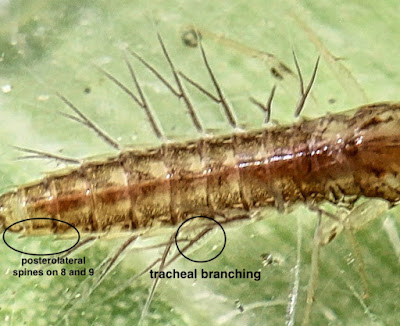Tuesday, July 28, 2020
Habrophlebiodes celeteria and americana: New pronggilled species
I have a number of blog entries lined up to post, so I thought I'd start with this one. I found this nymph yesterday in my favorite small mountain stream and knew right away that it was the mature version of one that I found on July 7. This one.
When I found this one on the 7th, I didn't know what it was, but I knew that it was a pronggilled nymph that I'd not seen before. With the help of some of my friends -- Steve Beaty, Matt Green, and Donna Bennett -- I was able to determine the ID.
At first, I thought it was genus Neoleptophlebia, seeing light tracheal branching in the gills,
but that turned out to be wrong. New genus, Habrophlebiodes. What I needed to see for that ID was a deep notch in the labrum, a feature that was easy to see on a specimen my friend Donna found in the same stream a number of years ago.
Habrophlebiodes also requires posterolateral spines on terga 8 and 9: I've pointed those out in the photo above that shows the tracheal branching.
What about the species ID? For that I turned to the "Clemson key," Morse, McCafferty, Stark, and Jacobus, eds., Larvae of the Southeastern USA: Mayfly, Stonefly, and Caddisfly Species, 2017. Habrophlebiodes species are keyed out on p. 138, and H. celeteria is clearly what we have.
"Head and mesonotum (dorsum of second thoracic segment) pale with some darker lines, pronotum and abdominal terga dusky yellowish, with abdominal terga paler at anterior margins and with pale mid-longitudinal stripe for length of dorsal abdomen; abdominal sterna 1-2 heavily pigmented and abdominal sterna 3-9 with pigmentation at posterolateral margins; mature body less than 4 mm."
The colors of the head, mesonotum, pronotum and abdominal terga are best seen in my specimen from July 7, and clearly they match the description. The pale areas at the anterior margins of the terga and the mid-longitudinal stripe can be seen in the photos of both of my specimens posted above.
For the markings of the abdominal sterna, they're best seen in a photo I took of my nymph from yesterday.
There is one other character trait for Habrophlebiodes that you can see on the specimen found by my friend. There's a pale triangle at the front of the head.
Cool! Habrophlebiodes celeteria.
____________________________
On July 12, one week after my H. celeteria find, I went to another small mountain stream, Entry Run in Greene County, and lo and behold, I found another Habrophlebiodes nymph, a different species: Habrophlebiodes americana!
The pale triangle at the front of the head is clearly visible in the second photo above. The branching on the gills, as well as the spines on terga 8 and 9, can be seen in the following photos. (Actually, there are spines on terga 7-10 in this species, as you can see in the photo.)
And this time, I managed to get my own photo of the notch in the labrum, clearly visible in this microscope shot.
But this did not look like H. celeteria, so what was the species? Same page in the "Clemson key," p. 138.
"Dorsum of head and body chestnut brown, without light mid-longitudinal stripe on abdomen."
Bingo! Habrophlebiodes americana.
____________________________
In the past, I've only rarely gone to my small mountain streams, assuming that all of the good critters were gone: nothing to see until winter and spring. Have to change my thinking on that one!
Here are a few more photos of the H. celeteria nymph that I found yesterday, shots from different angles.
Subscribe to:
Post Comments (Atom)














خدمات الرائع السعودي الان اصبحت الارخص في المملكة لاعربية السعودية حيث اننا نقدم لكم خدمات رش المبيدات التي تساعدك علي التخلص من كافة الحشرات في المنزل
ReplyDeleteشركة رش مبيدات بالرياض
شركة مكافحة حشرات بالرياض
شركة مكافحة النمل الابيض بالرياض
شركة مكافحة الحمام بالرياض
شركة مكافحة حشرات بجدة